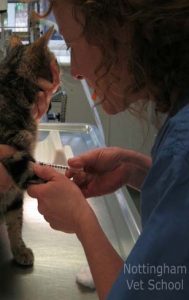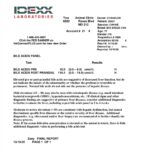Why Is My Dog Or Cat’s Bile Acid Level High or Low?
Ron Hines DVM PhD
 See What Normal Blood & Urine Values Are
See What Normal Blood & Urine Values Are
 Causes Of Most Abnormal Blood & Urine Tests
Causes Of Most Abnormal Blood & Urine Tests

The Bile Acids Level In Your Dog Or Cat’s Blood
Bile acids are formed in your cat or dog’s liver. The majority become a portion of your pet’s bile. These specialized digestive acids then collect in your pet’s gallbladder. From there they pass through its bile duct and into its upper intestine to aid in the absorption of the fat and oil in its diet. In that form, they are called bile salts.
As bile salts move past the small intestine and into your pet’s colon, a large portion of them are chemically modified by the bacteria that reside there. They are change from their original form, primary bile acids, into secondary bile acids. Some leave in the stool, but while in the colon, much is reabsorbed into your pet’s blood stream. Some of those secondary bile acids have hormone-like actions regarding your dog or cat’s blood glucose and cholesterol levels. But the majority are returned to its liver and added to your pet’s bile in an endless cycle. When your pet’s liver cells (hepatocytes) are injured or fewer in number or the normal blood circulation within your pet’s liver is altered (portal blood flow), this process breaks down. In some of those instances, your dog or cat’s blood bile acid test result numbers increase. In others, they decrease.
So, your dog or cat’s bile acid determination is a very good way for your veterinarian to detect liver problems – particularly when your pet’s ALT and bilirubin tests are only borderline normal/abnormal and difficult to interpret. Although a single bile acids test can be informative, two tests are much better: A 12-hour fast – then the first measurement. Then a moderately sized meal. Two hours after that, a second measurement.
Abnormal liver enzyme results in your pet are the most common reason for running as double bile acids test. But another valid reason to perform a double bile acids test is if anesthetics or sedatives have unusually strong effects on your dog or cat. “went too deep” “slept too long” Yet another are neurological issues such as abnormal behaviors – particularly when they tend to occur after meals. Another reason is a pet that fails to grow as expected for his or her breed. The bile acids test is also a good screening test when your pet has consistently low blood albumin levels that might indicate chronic liver issues. The albumin in its blood is manufactured in its liver.
Health Problems That Can Causes Bile Acid Levels To Be High:
Many forms of liver disease, abnormal liver blood flow (= portosystemic shunts), impaired gall bladder and bile duct function (cholestasis, or a biliary tract obstruction), gallstones, liver cancer, Cushing’s disease, pancreatitis, hepatic encephalopathy (=your pet’s liver can no longer convert the free blood ammonia generated by metabolism into less toxic urea).
Cats that have developed hepatic lipidosis because they are not eating often have abnormally high bile acid values.
Lipemic blood samples can falsely increase bile acid readings.
An abnormal bile acid test is not unusual in toy breeds born with hepatic microvascular dysplasia. It has been reported that bile acid levels can be naturally high in the Maltese breed. But perhaps that is due to the hepatic microvascular dysplasia problem that is common to all the toy breeds.
Health Problems That Can Cause Bile Acid Levels To Be Low:
One reason is long-standing intestinal disease (such as IBD in your dog or in your cat) when the upper portions of your pet’s intestine remain inflamed. Poor nutrient absorption (malabsorption/maldigestion) is another possible cause. Persistent diarrhea or starvation can all cause low blood bile acid readings.
Dogs less than 16 weeks old may have naturally lower levels. I do not know if this is also the case in kittens.
Serum bile acids can also be falsely reported as low if the blood sample was accidentally hemolyzed or lipemic. Low bile acid levels can result in a deficiency of the fat-soluble vitamins (=A, D, E & K). In cats, that problem has also been associated with a taurine deficiency.
Complementary Tests:
Complete blood chemistry including AP, GGT, Albumin, Glucose, BUN, AST, ALT, GDH/GLDH\ & bilirubin. A Liver doppler ultrasound examination. X-rays to see if your pet’s liver is of normal size. A liver biopsy. Perhaps a blood ammonia level determination – although that test has procedural and significance issues.
DxMe
You are on the Vetspace animal health website
Visiting the products that you see displayed on this website help pay the cost of keeping these articles on the Internet.



